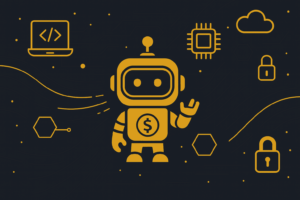Staking vs. Lending

Staking vs. Lending: Choosing the Right Investment Approach The Role of Staking in Blockchain Security
Introduction
Investing in the blockchain and cryptocurrency space has gained significant popularity in recent years. With various investment options available, it’s important to choose the right approach that aligns with your financial goals and risk appetite. Two popular investment methods in the crypto space are staking and lending. In this article, we will explore the differences between staking and lending, their benefits, risks, and how they contribute to blockchain security.
Understanding Staking
Staking refers to the process of actively participating in the validation and confirmation of transactions on a blockchain network. It involves holding and “staking” a certain amount of cryptocurrency to support network operations. Staking primarily relies on the Proof of Stake (PoS) mechanism, where validators are chosen based on the number of coins they hold and are willing to “stake” as collateral. In return for their contribution, validators receive rewards in the form of additional cryptocurrency tokens.
Staking offers several benefits to cryptocurrency holders. Firstly, it allows them to earn passive income by staking their coins and participating in network consensus. Additionally, staking helps to secure the blockchain network by ensuring that a sufficient number of honest and trustworthy validators are involved in the consensus process. However, staking also carries risks, such as potential slashing penalties for malicious behavior or network downtime.
Exploring Lending
Lending in the cryptocurrency world involves lending your digital assets to other users or platforms in exchange for interest payments. It is similar to traditional lending but operates on decentralized peer-to-peer lending platforms. These platforms connect lenders and borrowers directly, removing the need for intermediaries like banks. Lending offers advantages such as earning interest on your idle cryptocurrencies and diversifying your investment portfolio.
However, lending is not without risks. One significant risk is the potential default by borrowers, which could result in a loss of principal. Additionally, lending platforms may face technical vulnerabilities or regulatory challenges that can impact the safety of your investment.
Staking vs. Lending: A Comparative Analysis
When deciding between staking and lending, it’s important to consider several factors. One of the key factors is the risk and reward trade-off. Staking generally offers more predictable rewards but may have a lower return compared to lending, which carries higher interest rates but also higher default risks.
Liquidity is another aspect to consider. Staked cryptocurrencies are typically locked for a certain period, limiting their liquidity. In contrast, lending platforms often provide more flexibility in terms of withdrawing your funds when needed.
Market volatility and stability are crucial considerations as well. Staking rewards are often influenced by the overall market conditions, while lending interest rates may vary based on market demand and supply. Understanding how these factors can impact your investment is essential.
Security and centralization concerns are important, especially in the context of staking. While staking contributes to network security, it’s crucial to evaluate the decentralization and resilience of the blockchain project you’re staking on. Centralization of power within a blockchain network can pose risks to its long-term viability.
Governance and voting rights are also worth noting. Staking often comes with voting rights that allow token holders to participate in the decision-making process of the blockchain network. This can be appealing to those interested in actively shaping the future of a project. Lending, on the other hand, typically doesn’t provide such governance rights.
- Staking
Staking is primarily associated with proof-of-stake (PoS) and delegated proof-of-stake (DPoS) consensus mechanisms. In PoS, users lock up a certain amount of their cryptocurrency to become validators and participate in the block validation process. Validators are chosen based on their stake, and they receive rewards for maintaining the network’s security and integrity. DPoS is a variant of PoS where users delegate their stake to elected delegates who validate blocks on their behalf.
The benefits of staking are twofold. Firstly, stakers earn rewards in the form of additional tokens for their contributions to the network. These rewards can be significant, especially in networks with high adoption and demand for their tokens. Secondly, staking helps secure the network by increasing the cost of an attack and incentivizing honest participation.
- Lending
Lending in the cryptocurrency space is similar to traditional lending, where individuals lend their assets to borrowers in exchange for interest payments. Lending platforms act as intermediaries, matching lenders and borrowers and facilitating the lending process.
One of the primary benefits of lending is the ability to earn interest on idle cryptocurrency holdings. Depending on the lending platform and the market conditions, the interest rates can vary significantly. Lending also provides liquidity to the market by meeting the borrowing needs of individuals and institutions.

Factors to Consider When Choosing an Investment Approach
To select the right investment approach, it’s important to consider individual factors. Your investment goals and risk appetite play a significant role. Staking might be suitable for long-term holders seeking steady passive income, while lending could be appealing to investors looking for higher returns with a higher risk tolerance.
The available capital and time horizon also matter. Some staking platforms require a minimum stake, which might not be feasible for all investors. Lending, on the other hand, offers more flexibility in terms of investment amount. Additionally, the time horizon should align with the lock-up period for staking or the maturity period for lending.
Understanding the project and technology behind the cryptocurrencies you’re considering is crucial. Conduct thorough research on the project’s roadmap, team, and underlying technology to assess its potential for long-term success.
Regulatory and legal factors should not be overlooked. Cryptocurrency regulations can vary across jurisdictions, and it’s important to understand the legal implications of staking and lending activities in your country.
- Risk tolerance: Assess your risk tolerance level before investing. Some individuals are comfortable with high-risk investments, while others prefer lower-risk options. Understand your risk tolerance to align it with the appropriate investment approach.
- Investment goals: Clearly define your investment goals. Are you looking for short-term gains or long-term wealth accumulation? Your goals will influence the investment approach you choose.
- Time horizon: Consider your investment time horizon. Short-term investments may require a more conservative approach, while long-term investments allow for more aggressive strategies.
- Diversification: Diversify your investment portfolio to mitigate risk. Allocate your investments across different asset classes, sectors, and geographic regions to spread risk and potentially enhance returns.
- Market knowledge: Stay informed about the market trends, economic indicators, and industry developments related to your investment approach. Knowledge empowers you to make informed decisions.
- Cost and fees: Evaluate the costs and fees associated with your chosen investment approach. Consider expenses such as management fees, trading fees, and taxes to ensure they align with your financial goals.
- Professional advice: Seek advice from a financial advisor or investment professional. Their expertise can help you navigate the complexities of investing and make sound decisions.
Lastly, evaluate the platform or service provider you choose for staking or lending. Look for reputable platforms with a proven track record, transparent operations, and robust security measures.
The Role of Staking in Blockchain Security
Staking plays a vital role in enhancing blockchain security. By actively participating in the consensus mechanism, stakers help validate transactions and maintain the integrity of the network. Validators, the stakers responsible for confirming transactions, play a crucial role in preventing fraudulent activities and maintaining the blockchain’s trustworthiness.
Potential attacks on a blockchain network, such as 51% attacks or double-spending attempts, are mitigated through the involvement of a decentralized network of validators. The more validators participating in the staking process, the more secure and resistant the blockchain becomes to attacks.
Furthermore, staking contributes to network decentralization. It allows a wide range of participants to engage in the consensus process, reducing the concentration of power and control. Decentralization enhances the resilience and longevity of blockchain networks.
Conclusion
In the staking vs. lending debate, there is no one-size-fits-all solution. Choosing the right investment approach depends on various factors, including your investment goals, risk tolerance, and understanding of the project and technology. Staking offers passive income and network security, while lending provides higher potential returns but carries additional risks. By carefully considering these factors and conducting thorough research, you can make informed investment decisions in the crypto space.
FAQs (Frequently Asked Questions)
FAQ 1: Can I stake and lend my cryptocurrencies simultaneously?
Yes, in some cases, you can stake and lend your cryptocurrencies simultaneously. However, it’s important to research the specific platform or service provider you’re using to ensure they offer both staking and lending services for the cryptocurrencies you hold.
FAQ 2: Are staking and lending available for all cryptocurrencies?
No, staking and lending availability can vary depending on the cryptocurrency. Not all cryptocurrencies support staking or lending, so it’s important to check whether the cryptocurrencies you own are compatible with these investment approaches.
FAQ 3: How do I choose a reliable staking or lending platform?
When choosing a staking or lending platform, consider factors such as reputation, security measures, transparency, user reviews, and the platform’s track record. Look for platforms that have established themselves in the industry and have a strong community following.
FAQ 4: Is staking or lending more profitable?
The profitability of staking versus lending depends on various factors such as the cryptocurrency you choose, market conditions, interest rates, and risk factors. It’s important to evaluate the potential returns and associated risks before making an investment decision.
FAQ 5: What happens if a staking or lending platform gets hacked?
If a staking or lending platform gets hacked, it can potentially lead to the loss of your funds. It’s crucial to choose platforms with robust security measures, including cold storage of funds, strong encryption, and regular security audits. Additionally, consider diversifying your investments across multiple platforms to mitigate the risk of a single point of failure.

I have been in the industry for over 5 years. I know all the latest news and what is going on with different coins. I write about Bitcoin, Ethereum, Litecoin, and more.







